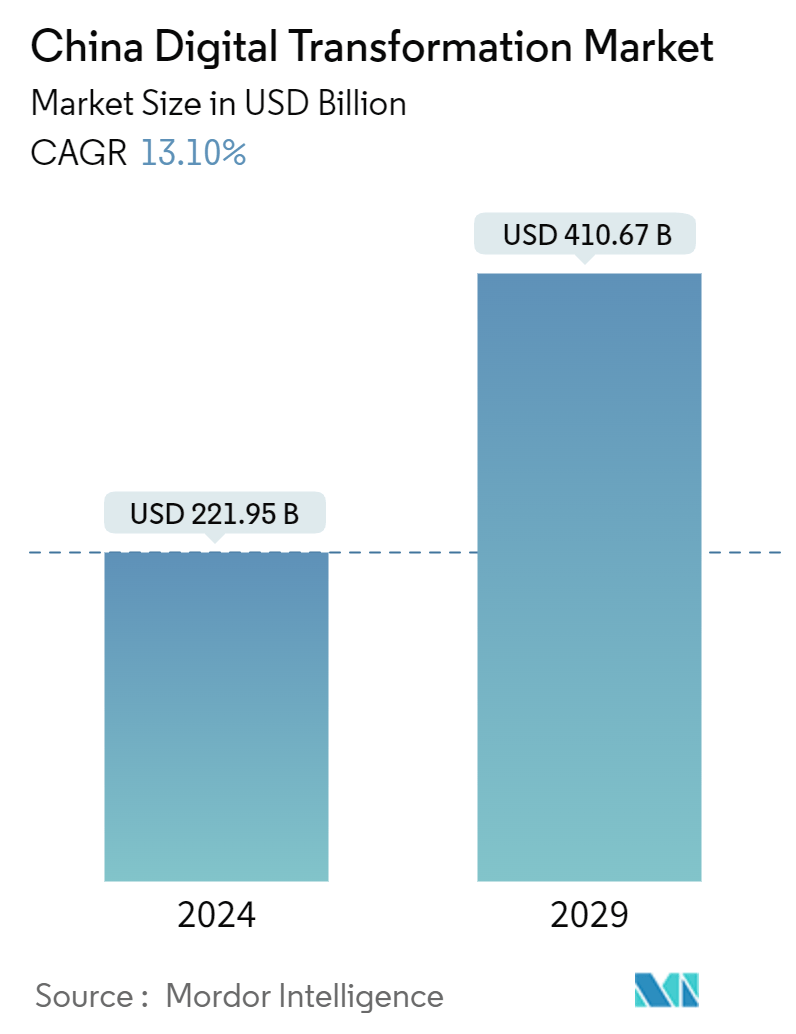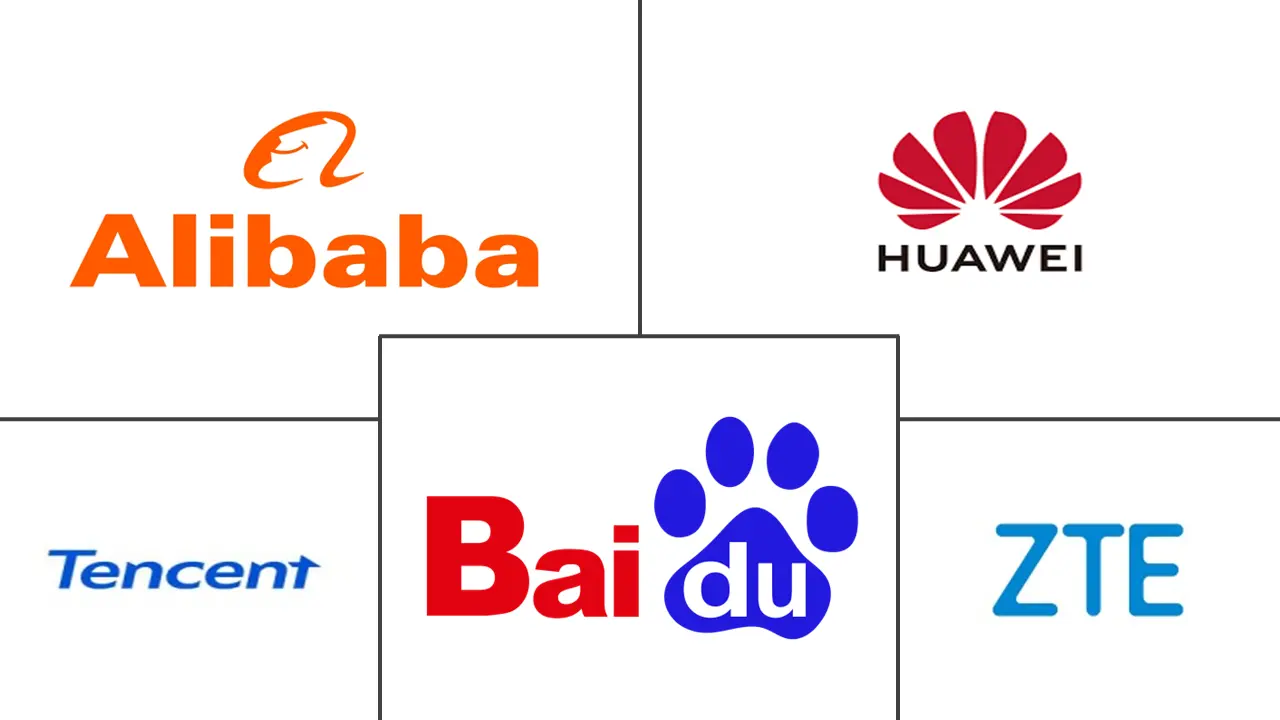Market Size of China Digital Transformation Industry

| Study Period | 2019 - 2029 |
| Base Year For Estimation | 2023 |
| Market Size (2024) | USD 221.95 Billion |
| Market Size (2029) | USD 410.67 Billion |
| CAGR (2024 - 2029) | 13.10 % |
| Market Concentration | Low |
Major Players
*Disclaimer: Major Players sorted in no particular order |
China Digital Transformation Market Analysis
The China Digital Transformation Market size is estimated at USD 221.95 billion in 2024, and is expected to reach USD 410.67 billion by 2029, growing at a CAGR of 13.10% during the forecast period (2024-2029).
- China's digital transformation market is experiencing robust growth, driven by government initiatives, technological advancements, and a strong push towards modernization across various sectors. This surge is largely influenced by the Chinese government's strategic plans like the "Made in China 2025" initiative and the widespread adoption of technologies such as artificial intelligence (AI), big data, cloud computing, and the Internet of Things (IoT). These advancements are reshaping traditional business models, improving operational efficiencies, and fostering innovation.
- One of the key factors contributing to this growth is the Chinese government's proactive stance on digital transformation. Policies and subsidies aimed at enhancing technological capabilities and infrastructure have created a conducive environment for both domestic and foreign companies to invest in digital solutions. Additionally, the widespread penetration of internet and mobile technologies has facilitated the rapid adoption of digital tools among businesses and consumers alike.
- In addition to this, key technology companies like Alibaba and Huawei are key players in the market. Alibaba, with its extensive ecosystem encompassing e-commerce, cloud computing, and fintech, provides comprehensive digital solutions that enable businesses to optimize their operations and reach a wider audience. Its cloud division, Alibaba Cloud, offers scalable computing resources and advanced analytics, empowering companies to harness the power of big data and AI for strategic decision-making. This not only enhances operational efficiency but also drives innovation in product development and customer engagement.
- Huawei, on the other hand, is a global provider in telecommunications and ICT infrastructure. Its focus on 5G technology and IoT solutions is revolutionizing connectivity and data exchange, enabling industries to implement smart manufacturing, autonomous logistics, and enhanced supply chain management. Huawei's robust R&D capabilities and strategic partnerships further bolster its ability to deliver cutting-edge digital solutions tailored to the unique needs of various industries.
- The digital transformation market in China is also fueled by the burgeoning startup ecosystem and increasing venture capital investments. This dynamic environment fosters innovation and accelerates the development and deployment of new technologies. Startups specializing in AI, blockchain, and cybersecurity are contributing significantly to the digital landscape, offering specialized solutions that address specific business challenges.
- Overall, China's digital transformation market is poised for continued growth, driven by government support, technological innovation, and the proactive efforts of key companies like Alibaba and Huawei. As businesses increasingly adopt digital solutions, the market is expected to evolve, with emerging technologies and startups playing a pivotal role in shaping the future of digital transformation in China.
China Digital Transformation Industry Segmentation
Digital transformation is the process of incorporating digital technologies such as analytics, artificial intelligence, and machine learning, extended reality (XR), Iot, industrial robotics, blockchain, additive manufacturing/3D printing, cybersecurity, cloud and edge computing, and others (digital Twin, mobility, and connectivity) in various end-user industries across the country.
China digital transformation market is segmented by type (analytics, artificial intelligence, and machine learning, extended reality (XR), IoT, industrial robotics, blockchain, additive manufacturing/3d printing, cybersecurity, cloud and edge computing, and others [digital twin, mobility, and connectivity]), end-user industry (manufacturing, oil, gas and utilities, retail & e-commerce, transportation and logistics, healthcare, bfsi, telecom and it, government and public sector, and others).
The market sizes and forecasts are provided in terms of value (USD) for the segments.
| By Type | ||||||
| ||||||
| ||||||
| ||||||
| ||||||
| ||||||
| ||||||
| ||||||
| ||||||
|
| By End-User Industry | |
| Manufacturing | |
| Oil, Gas and Utilities | |
| Retail & e-commerce | |
| Transportation and Logistics | |
| Healthcare | |
| BFSI | |
| Telecom and IT | |
| Government and Public Sector | |
| Others |
China Digital Transformation Market Size Summary
The China digital transformation market is experiencing significant expansion, driven by government initiatives, technological advancements, and a strong emphasis on modernization across various sectors. The Chinese government's strategic plans, such as the "Made in China 2025" initiative, alongside the adoption of technologies like artificial intelligence, big data, cloud computing, and the Internet of Things, are reshaping traditional business models and enhancing operational efficiencies. This growth is further supported by policies and subsidies that encourage technological investment, creating a favorable environment for both domestic and international companies. Key players like Alibaba and Huawei are instrumental in this transformation, offering comprehensive digital solutions that optimize business operations and drive innovation. The burgeoning startup ecosystem and increasing venture capital investments also contribute to the dynamic landscape, fostering innovation and the rapid deployment of new technologies.
The digital transformation market in China is also significantly impacting industries such as 3D printing, which has become a crucial tool for innovation across sectors like healthcare and aerospace. The integration of digital technologies has enabled faster and more efficient production processes, enhancing customization and supply chain management. In the telecom and IT sectors, companies like Huawei and ZTE are leading the charge with their investments in 5G technology and IoT solutions, revolutionizing connectivity and data exchange. The IT sector, with giants like Alibaba and Tencent, is witnessing remarkable growth, with Alibaba's cloud computing and AI technologies transforming sectors such as retail and finance. Overall, China's commitment to digital transformation, supported by substantial investments and strategic policies, positions it as a leader in the global digital economy, with companies actively expanding their reach beyond domestic borders.
China Digital Transformation Market Size - Table of Contents
-
1. MARKET DYNAMICS
-
1.1 Market Drivers
-
1.1.1 Increase in the adoption of big data analytics and other technologies in the region
-
1.1.2 The rapid proliferation of mobile devices and apps
-
-
1.2 Market Restraints
-
1.2.1 Concerns about the Privacy and Security of Information
-
-
-
2. MARKET SEGMENTATION
-
2.1 By Type
-
2.1.1 Analytics, Artificial Intelligence and Machine Learning
-
2.1.1.1 Current Market Scenario and Market Projections for the Forecast Period
-
2.1.1.2 Key Growth Influencers (Drivers, Challenges, and Opportunities)
-
2.1.1.3 Use Case Analysis
-
2.1.1.4 Market Outlook
-
-
2.1.2 Extended Reality (XR)
-
2.1.2.1 Current Market Scenario and Market Projections for the Forecast Period
-
2.1.2.2 Key Growth Influencers (Drivers, Challenges, and Opportunities)
-
2.1.2.3 Use Case Analysis
-
2.1.2.4 Market Outlook
-
-
2.1.3 IoT
-
2.1.3.1 Current Market Scenario and Market Projections for the Forecast Period
-
2.1.3.2 Key Growth Influencers (Drivers, Challenges, and Opportunities)
-
2.1.3.3 Use Case Analysis
-
2.1.3.4 Market Outlook
-
-
2.1.4 Industrial Robotics
-
2.1.4.1 Current Market Scenario and Market Projections for the Forecast Period
-
2.1.4.2 Key Growth Influencers (Drivers, Challenges, and Opportunities)
-
2.1.4.3 Use Case Analysis
-
2.1.4.4 Market Outlook
-
-
2.1.5 Blockchain
-
2.1.5.1 Current Market Scenario and Market Projections for the Forecast Period
-
2.1.5.2 Key Growth Influencers (Drivers, Challenges, and Opportunities)
-
2.1.5.3 Market Outlook
-
-
2.1.6 Additive Manufacturing/3D Printing
-
2.1.6.1 Current Market Scenario and Market Projections for the Forecast Period
-
2.1.6.2 Key Growth Influencers (Drivers, Challenges, and Opportunities)
-
2.1.6.3 Use Case Analysis
-
2.1.6.4 Market Outlook
-
-
2.1.7 Cyber security
-
2.1.7.1 Current Market Scenario and Market Projections for the Forecast Period
-
2.1.7.2 Key Growth Influencers (Drivers, Challenges, and Opportunities)
-
2.1.7.3 Use Case Analysis
-
2.1.7.4 Market Outlook
-
-
2.1.8 Cloud and Edge Computing
-
2.1.8.1 Current Market Scenario and Market Projections for the Forecast Period
-
2.1.8.2 Key Growth Influencers (Drivers, Challenges, and Opportunities)
-
2.1.8.3 Use Case Analysis
-
2.1.8.4 Market Outlook
-
-
2.1.9 Others
-
2.1.9.1 Current Market Scenario and Market Projections for the Forecast Period
-
2.1.9.2 Key Growth Influencers (Drivers, Challenges, and Opportunities)
-
2.1.9.3 Use Case Analysis
-
2.1.9.4 Market Outlook
-
-
-
2.2 By End-User Industry
-
2.2.1 Manufacturing
-
2.2.2 Oil, Gas and Utilities
-
2.2.3 Retail & e-commerce
-
2.2.4 Transportation and Logistics
-
2.2.5 Healthcare
-
2.2.6 BFSI
-
2.2.7 Telecom and IT
-
2.2.8 Government and Public Sector
-
2.2.9 Others
-
-
China Digital Transformation Market Size FAQs
How big is the China Digital Transformation Market?
The China Digital Transformation Market size is expected to reach USD 221.95 billion in 2024 and grow at a CAGR of 13.10% to reach USD 410.67 billion by 2029.
What is the current China Digital Transformation Market size?
In 2024, the China Digital Transformation Market size is expected to reach USD 221.95 billion.

